What is a Leaf Pack?
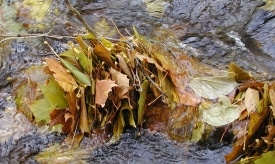
The leaves that fall into streams accumulate in packs behind branches, rocks, and other obstructions, forming natural leaf packs.
Streams and the life in those streams evolved and developed under forested conditions. As an example, most streams in the eastern United States historically were forested. Leaf fall from the forest canopy prevailed as the dominant food resource for small streams. All ecosystems rely on a steady supply of energy. Solar energy drives photosynthesis that supplies carbon (chemical energy) for the rest of the system. In many headwater streams, however, sunlight cannot reach the water’s surface due to shading of the forest canopy. Therefore, most headwater streams rely on autumn leaf fall to supply much of the carbon needed to support the stream throughout the year.
Leaves falling in or near the stream leach out organic molecules, creating a “watershed tea” that flows downstream and provides nourishment along the way. On the leaf surface, there is a diverse assemblage of microbes (fungi and bacteria) and macroinvertebrates (insect larvae, crustaceans, etc.), which “process” leaves and facilitate the flow of energy through the system. The amount and variety of leaves that are available to the stream community are determined by the presence, health, and diversity of the surrounding streamside (riparian) vegetation.
Leaf Packs as Habitat
Many leaves that fall or are blown into a stream float downstream until they land on a rock within a riffle. Riffles are areas in a stream where the bottom is rocky and the water is fast flowing. The leaves accumulate behind the rocks forming natural leaf packs. The artificial leaf packs created in the Leaf Pack Stream Ecology Kit mimic these natural leaf packs. In natural and artificial leaf packs, after a few weeks of submersion, the leaves become slimy with the colonization of fungus and bacteria and, in time, are colonized by macroinvertebrates.
Leaf packs provide important habitat for macroinvertebrates in healthy streams. The physical features of the stream itself offer many different types of habitats, which in turn support specialized
macroinvertebrates that occupy certain niches in each of those different habitats. For example, riffles (fast-flowing, rocky areas) characteristically offer diverse environments and the fast-flowing water offers a continuous supply of oxygen and food to macroinvertebrates. Slow-flowing, muddy-bottomed habitats, such as pools, facilitate a very different habitat; they support macroinvertebrates adapted to these specific conditions and contain different species compared to the macroinvertebrates found in riffles. Other stream habitats that can be investigated include sandy/silty bottoms, areas near vegetated banks, and areas having an accumulation of woody debris. Each type of habitat will offer a unique assemblage of macroinvertebrate species.
Streams are naturally dynamic environments, often exhibiting marked variation in conditions such as stream flow (e.g., floods or drought), temperature (e.g., warm versus cold), and food quality or quantity (e.g., autumn leaf fall or summer algal blooms). This variation in conditions occurs annually, seasonally, and daily, and contributes significantly to the variety and abundance of macroinvertebrates in streams.
Freshwater Macroinvertebrates
Once a leaf pack has been submerged in a stream for several weeks, bacteria and aquatic fungi (decomposers) will begin to colonize the surface of the leaves. Leaf detritus colonized by these microbes feels “slimy.” As the fungi and bacteria break down the leaves, benthic freshwater macroinvertebrates enter the leaf pack and begin their function of further breaking down the leaves. Benthic freshwater macroinvertebrates can be defined as the following:
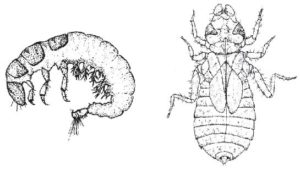
Benthic = inhabit bottom areas/substrates
Freshwater = streams, rivers, lakes, ponds
Macro = relatively “large” (> 0.2-0.5mm)
Invertebrate = animal without vertebrae
These macroinvertebrates play important roles in the food webs of the stream ecosystem. Leaves can be difficult for macroinvertebrates to digest and often contain nutrients that are hard to absorb. The aquatic fungi and bacteria that colonize leaves as a first step in the decomposition process provide an essential component to the macroinvertebrate diet. Research indicates that different leaf types offer different levels of nutrition for freshwater macroinvertebrates. Experimenting with different types of tree leaves may yield a better understanding as to which leaf type certain macroinvertebrates prefer.
Life Cycles of Aquatic Insects
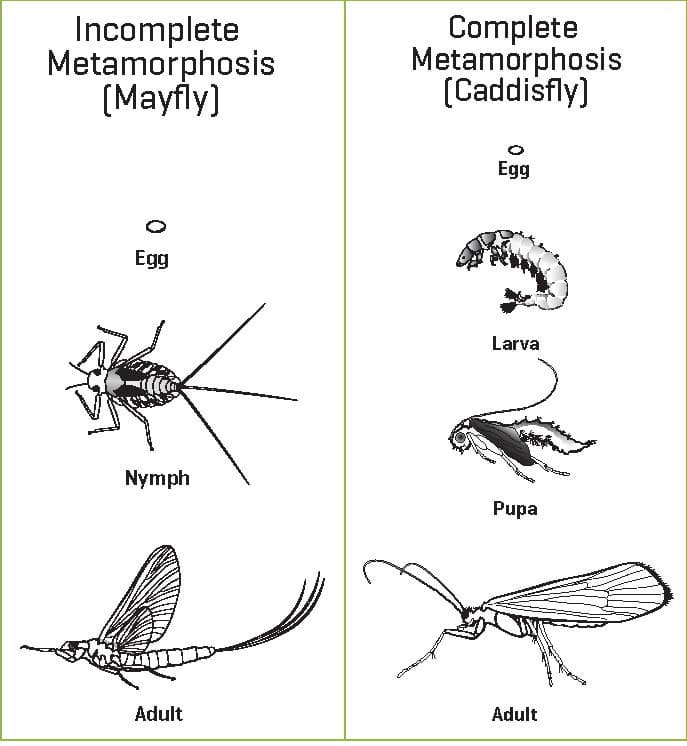 Many macroinvertebrates are aquatic insects, that go through several stages from egg to adult. The number of stages depends on the type of metamorphosis or series of developmental changes that are followed. Insects that undergo incomplete metamorphosis follow three stages. They begin as eggs that hatch into nymphs, which then grow into adults. The immature period is called the nymphal stage. Examples of insects that undergo incomplete metamorphosis are mayflies, dragonflies, damselflies, stoneflies, and true bugs. Many of the insects that undergo incomplete metamorphosis are aquatic only during the egg and nymphal stages. The winged adults do not live in the water. Dragonflies, for example, can often be seen in the adult form flying along streams and rivers in the summer.
Many macroinvertebrates are aquatic insects, that go through several stages from egg to adult. The number of stages depends on the type of metamorphosis or series of developmental changes that are followed. Insects that undergo incomplete metamorphosis follow three stages. They begin as eggs that hatch into nymphs, which then grow into adults. The immature period is called the nymphal stage. Examples of insects that undergo incomplete metamorphosis are mayflies, dragonflies, damselflies, stoneflies, and true bugs. Many of the insects that undergo incomplete metamorphosis are aquatic only during the egg and nymphal stages. The winged adults do not live in the water. Dragonflies, for example, can often be seen in the adult form flying along streams and rivers in the summer.
Insects that undergo complete metamorphosis have four stages: egg, larva, pupa, and adult. They begin as eggs that hatch into tiny larvae; these larvae grow and eventually enter a pupal stage in which the insects are transformed into an adult (in a similar way that a caterpillar once in the chrysalis is transformed into a butterfly). The immature period is called the larval stage. Examples of aquatic insects that go through complete metamorphosis are true flies, beetles,caddisflies, and dobsonflies.
Many insects that undergo complete metamorphosis are aquatic during the egg, larval, and pupal stages, but not as adults. Some insects like the whirligig beetle and predaceous diving beetle pupate out of the water in overhanging tree branches and return to the water as adults.
The majority of insects found in leaf packs will be in the nymphal or larval stage. The total life cycle of
macroinvertebrates ranges from less than two weeks for some true flies (midges and mosquitoes), to two years or longer for some stoneflies, dragonflies, and dobsonflies.
Water Quality Indicators
The ability of freshwater macroinvertebrates to flourish not only depends upon optimal physical factors but also on chemical factors in their environment. Many macroinvertebrates require a specific range of aquatic chemical parameters (pH, dissolved oxygen, temperature, alkalinity, etc.) to survive. The presence or absence of these organisms in a stream can be used to reveal the overall ecological quality of the water. Generally, unpolluted waters support a greater variety of freshwater macroinvertebrates than polluted waters. There are some macroinvertebrates, however, that can tolerate polluted waters, and these may be found in a greater abundance in polluted waters than in unpolluted waters. As “canaries of the stream,” these organisms are exposed to all of the pollutants coming into the stream and serve as living barometers that can indicate changes in water quality. Therefore, macroinvertebrates can act as bioindicator organisms to estimate the water quality and the overall health of the stream community.
Since streams are a complex ecosystem, when introducing artificial leaf packs to a particular stream environment, it may also be informative to collect chemical and physical data using a variety of field test kits and visual surveys to provide the most comprehensive assessment of the stream.
Functional Feeding Groups
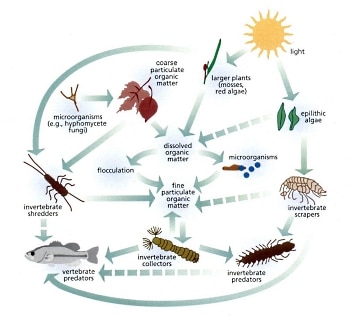
Food web in small streams. Image provided by, “Stream Corridor Restoration: Principles, Processes, and Practices, 10/98, by the Federal Interagency Stream Restoration Working Group (FISRWG).”
Macroinvertebrates can be classified not only by traditional taxonomy but also by how they function in the ecosystem. This method of classification based on feeding adaptations and/or food preferences is known as functional feeding groups.
In a simplified view of the food web, these groups process leaf detritus in a stepwise fashion. Large detrital pieces and their associated microorganisms (fungi and bacteria) are eaten by certain, highly specialized macroinvertebrates. This process yields smaller particles (feces and leaf fragments, similar to crumbs created after eating crackers, for example), providing food for other functional feeding groups further downstream. These macroinvertebrates, in turn, are an important food source for predators. Ecologically, macroinvertebrates are a primary link between the base of the food web (algae, detritus, and microorganisms) and larger animals near the top of the food web such as fish.
There are a number of feeding strategies including the shredders which break down leaves. Shredders (which include crane flies, some caddiflies and stoneflies, sowbugs, and scuds) break the leaves down into fine particles by eating them. Drifting downstream, the fine particles become food for another group of detritus feeders, the collectors.
Collectors use various methods to filter or gather the fine particles. Filtering collectors such as the black fly use fan-like filaments near the mouth to capture food particles. Other filtering collectors, such as the net-spinning caddisflies, construct web-like nets. Gathering collectors include some mayflies and midges.
The grazers (also known as scrapers) are another group of freshwater macroinvertebrates present in the stream community, however these organisms feed on the algae that grow on the surface of rocks. They include some caddisflies, the water penny (a beetle), and certain midges and mayflies.
The shredders, collectors, and grazers are food sources for predators, which include other macroinvertebrates such as dobsonflies and the dragonflies. Predators have large, powerful mouthparts used for grasping prey. All macroinvertebrates, in turn, are food for fish and birds.
| Feeding Strategy | Food Category |
|---|---|
| I. Shredders | Dead leaves/live macrophytes |
| II. Collectors | Fine organic particles (live/dead) |
| Filter feeders | Particles in water column |
| Miners | Buried particles |
| Browsers | Bottom surface deposits |
| III. Scrapers | Live benthic algae (diatoms) |
| IV. Piercers | Live filamentous algae |
| V. Predators | Other invertebrates + small fish |
Stream Size and the Macroinvertebrate Community
Leaf fall from the forest canopy in small streams is a valuable food source for shredders, the macroinvertebrates that get nutrition primarily from the fungi and bacteria that colonize the leaf surface. Crane flies, stoneflies, caddisflies and aquatic sow bugs are all important members of this group.
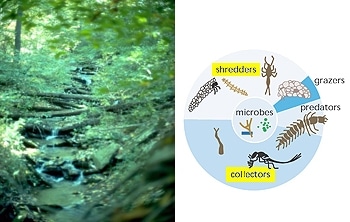
Shredders and collectors form the major portion of stream macroinvertebrates.
As the stream widens, trees do not overhang as much of the water surface so it is exposed to sunlight and in-stream photosynthesis plays a more important role in the aquatic food web. The amount of leaf litter reaching the stream decreases and algae, due to the increased sunlight, becomes more abundant. As the food base shifts, so does the type of invertebrates. Grazers/scrapers that utilize the abundant algal resource increase while shredders decrease. Snails, limpets, certain mayflies and case-building caddisflfies are adapted to feeding on the algae growing on rock surfaces.
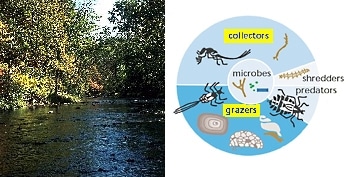
Collectors gather or filter plant fragments, feces, and plankton. Grazers, aka scrapers, browse on algae.
Further downstream, the river channel widens and deepens. Trees shade only the water’s edge, and sunlight, although abundant, does not penetrate to the river bottom due to turbidity caused by runoff from the land. The food base is dominated by phytoplankton and fine suspended organic particles generated farther upstream and from the river’s floodplain. Filtering collectors such as mussels and clams are adapted to filtering these fine particles from the water column. To complete the food web ecology, a diverse group of predators are found throughout the entire stream length feeding on all other feeding groups.
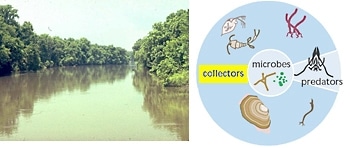
Filtering collectors such as mussels are found in greater abundance in larger streams and rivers.
A Continuum of Life
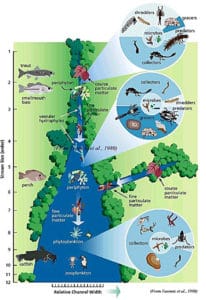
The River Continuum Concept (click image to enlarge). Source: Stream Corridor Restoration: Principles, Processes, and Practices, 10/98, by the Federal Interagency Stream Restoration Working Group (FISRWG)
Stroud Water Research Center’s first director had an innovative idea of studying the entire watershed as opposed to only studying sections of a stream as had been done in the past. Physical conditions vary greatly in small headwater streams compared to large rivers. For example, a river’s width, depth, velocity and temperature change constantly as the water flows downstream. More importantly, those changes are interrelated — and because a change in one factor affects all the others, a river’s pattern is predictable and a continuum. Not only does a stream change physically as it flows downstream, it also changes biologically.
The River Continuum Concept seeks to correlate this continuum of physical changes with biological changes throughout a river system and provides a conceptual model to compare with stream systems throughout the world. It was the first unified hypothesis about how streams and their watersheds work. It dominated river studies for the next decade, and it established the Center as a pioneer in innovative research. Read more about The River Continuum Concept


